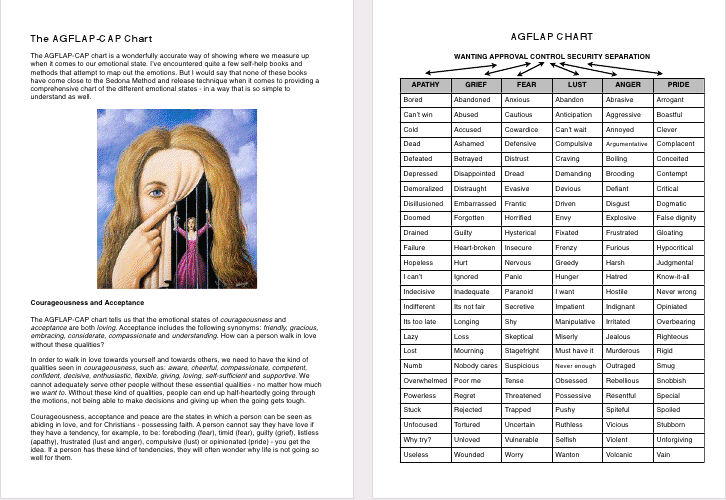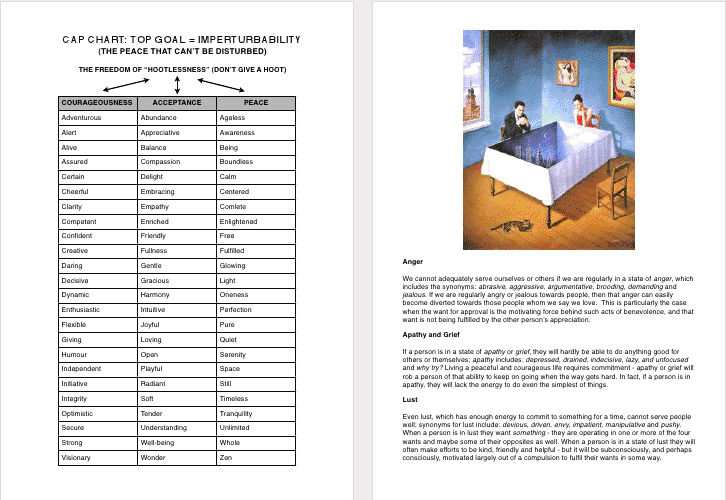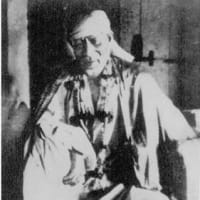HOW TO RELEASE PAINFUL EMOTIONS THE SEDONA METHOD - 2
HOW TO RELEASE PAINFUL EMOTIONS THE SEDONA METHOD - 1 (P1~15)
HOW TO RELEASE PAINFUL EMOTIONS THE SEDONA METHOD - 2 (P16~27)
HOW TO RELEASE PAINFUL EMOTIONS THE SEDONA METHOD by DR SUSAN KRIEGLER
痛い感情をリリース(解放)する方法、セドナメソッド (痛みを伴う感情の解放への方法が、セドナメソッド)
注記:2017年3月21日(火) 18:29JST 現在
下記のURL、http://search-document.com は、
The domain search-document.com is for sale. になり、
ebookbrowse.com は、Redirect になり危険なので
リンクを止めました。
現在、有効なリンクのみにしました。
閲覧
SEDONA METHOD - Search-Document.com (閲覧できます。英語)
5411d9 a741a45b166bd1c88e284176bf678735 pdf?dn SEDONA METHOD (3) pdf - free ebook download from media.wix.com (閲覧できます。英語)
ダウンロード
http://media.wix.com/ugd/5411d9_a741a45b166bd1c88e284176bf678735.pdf?dn=SEDONA_METHOD+(3).pdf (ダウンロードできます。英語) (全27ページ)
HOW TO RELEASE
PAINFUL EMOTIONS
THE SEDONA METHOD
DR SUSAN KRIEGLER
(P16~P27 までを以下に記載しました。)
----------
Be the Freedom You Want
If you`ve listened to the audios you may have heard Lester talking about going high to
release. This means getting into a high emotional state before releasing AGFLAP. That way
you are in a much more resourceful state and you can let go of the heavy issues much more
easily.
This is a key distinction Rich Furlanic noted when developing the Lesterizing process. A
core principle in Lesterizing is getting into the state of goal havingness before letting go of
the AGFLAP in the way of having the goal. At the same time you make sure to have step one
in place - you decide you want freedom more than you want the goal. Then its as if you are
looking down on the goal from a place of power over it, rather than striving to grow to get it.
How do you get into the freedom state?
You decide to! Simply pretend you can and imagine how it would feel right now in this present
moment. How would you sit, how would you breathe and what feelings would you focus on in
your body? This is all about using some imagination to create that state in the present here
and now. It feels just like making it up - because you are!
Maintain the freedom state.
Then release as you usually do. Maybe you like to use attachments and aversions. Release
on a polarity, then check you are in the freedom state. If you are not, get back into freedom
before releasing on the next polarity. And so on..
----- 16 -----
The AGFLAP-CAP Chart
The AGFLAP-CAP chart is a wonderfully accurate way of showing where we measure up
when it comes to our emotional state. Iʼve encountered quite a few self-help books and
methods that attempt to map out the emotions. But I would say that none of these books
have come close to the Sedona Method and release technique when it comes to providing a
comprehensive chart of the different emotional states - in a way that is so simple to
understand as well.
Courageousness and Acceptance
The AGFLAP-CAP chart tells us that the emotional states of courageousness and
acceptance are both loving. Acceptance includes the following synonyms: friendly, gracious,
embracing, considerate, compassionate and understanding. How can a person walk in love
without these qualities?
In order to walk in love towards yourself and towards others, we need to have the kind of
qualities seen in courageousness, such as: aware, cheerful, compassionate, competent,
confident, decisive, enthusiastic, flexible, giving, loving, self-sufficient and supportive. We
cannot adequately serve other people without these essential qualities - no matter how much
we want to. Without these kind of qualities, people can end up half-heartedly going through
the motions, not being able to make decisions and giving up when the going gets tough.
Courageousness, acceptance and peace are the states in which a person can be seen as
abiding in love, and for Christians - possessing faith. A person cannot say they have love if
they have a tendency, for example, to be: foreboding (fear), timid (fear), guilty (grief), listless
(apathy), frustrated (lust and anger), compulsive (lust) or opinionated (pride) - you get the
idea. If a person has these kind of tendencies, they will often wonder why life is not going so
well for them.
----- 17 -----

AGFLAP CHART

WANTING APPROVAL CONTROL SECURITY SEPARATION
APATHY
Bored
Canʼt win
Cold
Dead
Defeated
Depressed
Demoralized
Disillusioned
Doomed
Drained
Failure
Hopeless
I canʼt
Indecisive
Indifferent
Its too late
Lazy
Lost
Numb
Overwhelmed
Powerless
Stuck
Unfocused
Why try?
Useless
GRIEF
Abandoned
Abused
Accused
Ashamed
Betrayed
Disappointed
Distraught
Embarrassed
Forgotten
Guilty
Heart-broken
Hurt
Ignored
Inadequate
Its not fair
Longing
Loss
Mourning
Nobody cares
Poor me
Regret
Rejected
Tortured
Unloved
Wounded
FEAR
Anxious
Cautious
Cowardice
Defensive
Distrust
Dread
Evasive
Frantic
Horrified
Hysterical
Insecure
Nervous
Panic
Paranoid
Secretive
Shy
Skeptical
Stagefright
Suspicious
Tense
Threatened
Trapped
Uncertain
Vulnerable
Worry
LUST
Abandon
Anticipation
Canʼt wait
Compulsive
Craving
Demanding
Devious
Driven
Envy
Fixated
Frenzy
Greedy
Hunger
I want
Impatient
Manipulative
Miserly
Must have it
Never enough
Obsessed
Possessive
Pushy
Ruthless
Selfish
Wanton
ANGER
Abrasive
Aggressive
Annoyed
Argumentative
Boiling
Brooding
Defiant
Disgust
Explosive
Frustrated
Furious
Harsh
Hatred
Hostile
Indignant
Irritated
Jealous
Murderous
Outraged
Rebellious
Resentful
Spiteful
Vicious
Violent
Volcanic
PRIDE
Arrogant
Boastful
Clever
Complacent
Conceited
Contempt
Critical
Dogmatic
False dignity
Gloating
Hypocritical
Judgmental
Know-it-all
Never wrong
Opiniated
Overbearing
Righteous
Rigid
Smug
Snobbish
Special
Spoiled
Stubborn
Unforgiving
Vain
----- 18 -----

CAP CHART: TOP GOAL = IMPERTURBABILITY
(THE PEACE THAT CANʼT BE DISTURBED)

THE FREEDOM OF “HOOTLESSNESS” (DONʼT GIVE A HOOT)
COURAGEOUSNESS
Adventurous
Alert
Alive
Assured
Certain
Cheerful
Clarity
Competent
Confident
Creative
Daring
Decisive
Dynamic
Enthusiastic
Flexible
Giving
Humour
Independent
Initiative
Integrity
Optimistic
Secure
Strong
Visionary
ACCEPTANCE
Abundance
Appreciative
Balance
Compassion
Delight
Embracing
Empathy
Enriched
Friendly
Fullness
Gentle
Gracious
Harmony
Intuitive
Joyful
Loving
Open
Playful
Radiant
Soft
Tender
Understanding
Well-being
Wonder
PEACE
Ageless
Awareness
Being
Boundless
Calm
Centered
Comlete
Enlightened
Free
Fulfilled
Glowing
Light
Oneness
Perfection
Pure
Quiet
Serenity
Space
Still
Timeless
Tranquility
Unlimited
Whole
Zen
----- 19 -----
Anger
We cannot adequately serve ourselves or others if we are regularly in a state of anger, which
includes the synonyms: abrasive, aggressive, argumentative, brooding, demanding and
jealous. If we are regularly angry or jealous towards people, then that anger can easily
become diverted towards those people whom we say we love. This is particularly the case
when the want for approval is the motivating force behind such acts of benevolence, and that
want is not being fulfilled by the other personʼs appreciation.
Apathy and Grief
If a person is in a state of apathy or grief, they will hardly be able to do anything good for
others or themselves; apathy includes: depressed, drained, indecisive, lazy, and unfocused
and why try? Living a peaceful and courageous life requires commitment - apathy or grief will
rob a person of that ability to keep on going when the way gets hard. In fact, if a person is in
apathy, they will lack the energy to do even the simplest of things.
Lust
Even lust, which has enough energy to commit to something for a time, cannot serve people
well; synonyms for lust include: devious, driven, envy, impatient, manipulative and pushy.
When a person is in lust they want something - they are operating in one or more of the four
wants and maybe some of their opposites as well. When a person is in a state of lust they will
often make efforts to be kind, friendly and helpful - but it will be subconsciously, and perhaps
consciously, motivated largely out of a compulsion to fulfil their wants in some way.
----- 20 -----
The Want for Approval and False Love
The want for approval is a huge motivator for those who do seek to do nice things for people.
I have seen many people who say they love their husband / wife. But they complain that they
have invested so much time and effort into the marriage, only to find that they are at
loggerheads with their partner and their efforts donʼt seem to gain them the reward, attention
and appreciation they were hoping for.
The Need to Let Go of Pent-Up Emotion
The AGFLAP-CAP chart of emotions can give us a clue as to why our best efforts to be kind
to other people never seem to endure or fulfil our expectations. We can become more aware
of our real intentions by focusing on our emotional state in relation to our actions. This is not
intended to put someone into a state of morbid introspection, but to simply become aware of
our feelings so that we can release them effectively.
If not released, these negative emotions simply become ignored, repressed or expressed in
the wrong way. Repressed emotions often become expressed through other channels when
the emotions become too much to contain and when the opportunity presents itself - often
when a person least expects it. You could see releasing as a means of opening these
emotional “pressure valves” as a means of letting go of pent-up emotion.
Releasing versus Positive Thinking
Living life by a set of rules simply does not work. There are scores of Christian books that
advocate following principles and maintaining a positive attitude as a means of being
blessed. There are also scores of secular self-help books which do a very similar thing. In all
of these methods the onus is put on the adherent to think positively - which is often easier
said than done! Releasing offers a simple and effective solution to this dilemma by allowing
the ability to release emotions and their underlying wants.
----- 21 -----
The Subject of Love from Lester's Viewpoint
Lester Levenson often said that Love was one of the most often used but misunderstood
words in human experience. What Love brings to mind for most of us is that first kiss with our
high school sweetheart, or meeting our spouse-to-be for the first time.
When we "fall in Love" there is a real chemical cocktail that is uncorked, poured into our
blood, and we feel high, giddy, and for a time, the world is a blissful place. We see our
beloved bathed in Love-colored hues, and he/she is perfect.
I've often thought if they could put this into a pill, we'd have a drug problem of horrendous
proportions! Lester said that human Love is totally different from the way a Master defines
Love, which is the real Love of Beingness/God. He said that human Love is a very limited
thing.
"You do this for me, and I will Love you." I, in turn will do that for you, and you will Love me."
In Latin, we use the term :Quid Pro Quo, or "this for that". There is the law of mutuality always
running, and this so-called Love is partly a type of human arrangement for some kind of
desired result. It could be a planned family, a promising business future, or a myriad of other
lustful fantasies.
These fantasies may or may not work out, and even if they do, there is no guarantee that
Love, Inc. will survive. After all, the reminder of that drug is always on our minds, and that is
why we hear about so much infidelity and affairs. The same person who incited that cocktail
just can't do it any more. Sound familiar?
At a New York City impromptu short lecture Lester gave, he made this powerful statement,
"LOVE, LOVE, LOVE, and you'll be so happy....and healthy....and prosperous!" How could
that be? The secret lies in Lester's definition of Love. "Love is total selflessness. Wanting for
the other one what he/she wants for themselves (not what we want).
----- 22 -----
Love is someone knowing that "I AM YOU." On the feeling chart, Love is very high, in
ACCEPTANCE, right below total PEACE. So, we need to query ourselves, "Am I really
loving?" Probably not, most of the time. When we Love our pets or someone's newborn
infant, we feel this Love. Love is Giving, with no thought of Receiving, wanting nothing from
the other one. Difficult? Not really, according to Lester. He said, "Loving people is the easiest
thing to do." Then why does it seem so hard to Love people? How many of you have heard
others say, "If only people were as easy to Love as dogs."
The reason for that is simple. Just like our dog, we want them to just be there when we get
home, wag their tails or purr, take walks with us, etc., and Love us for what we are, not what
we are not. We want them to forget our scolding yesterday, or that we forgot their favorite
cookies. This is easy for dogs, because they exist in the NOW moment.
We humans have a hard time loving people because we fear rejection. We put up walls
around ourselves to protect us from any more hurt and to buffer the pain we are sure is to
come. We want Love instead of feeling safe to give Love. Lester said "Wanting equates to not
having." So when we want Love, we create the opposite, or rejection. Lester was often heard
to say, "Every feeling is a non-Love feeling." Fear, Pride, Grief, Apathy, etc. are all
expressions of non-Love. So when we release the Wanting Love program, it takes thousands
of non-Love feelings with it!
----- 23 -----
Because Love is such a high state, you are in tune with the Whole Universe, which is ALL
LOVING. When the mind is quiet with no thoughts and feelings, all the power of one's Self is
available, untethered by the baggage of the past (the want programs).
If we would Love all the time, we would achieve a very successful and happy life. Loving
totally would amazingly give us all the knowledge we seek as well. So what keeps us from
doing this? Just holding on to non-Love feelings we think will protect us, but in fact cause us
so much trouble and heartache.
The very fear of rejection causes us to be rejected. Anger at him/her for something said
causes us to create the same thing over again with someone else! Also, because Love is
such a high state, it automatically will bring up all the AGFLAP, or non-Love feelings, just as
wording a goal in a high energy. If you make it a goal to “Love people no matter what," it may
stir up a whole hornetʼs nest of non-Love feelings. That is why intimate relationships, and
especially marriages, where we promise to Love, stir up so many non-Love feelings, and are
such wonderful places to practice releasing.
Each time you remember the Truth of who you are, you bring more Light into the world.
----- 24 -----
Setting and Attaining Goals
The procedure involves three steps:
• EXPERIENCE IT
• LET IT GO
• AND MAKE IT SO
Formulate Your Goal:
In the NOW, as if it is already achieved
In positive terms
So it feels realistic and attainable
Include yourself in the statement
Be precise and concise
Be specific but not limiting
•
•
•
•
•
•
Remember to:
Eliminate the word “want”
Facilitate letting go
State the end result, not the steps / means of achieving it
Relate your goal to courage, acceptance, or peace
•
•
•
•
----- 25 -----
Examples:
I allow myself to love and accept myself or .................. no matter what.
I allow myself easily to achieve and maintain my ideal body weight.
I allow myself to enjoy eating foods that keep my body slender, healthy, and fit.
I allow myself easily and naturally to establish and maintain a lifestyle and habits that
promote my emotional wellbeing and peace of mind.
I allow myself lovingly to support ..................... in his / her growth and freedom.
I allow ........................ to have what he / she wants for him / herself.
I allow my relationship with ......................... to be easy, relaxed, harmonious, loving,
open and mutually beneficial.
I allow myself effortlessly to run my business efficiently and successfully.
I allow myself to feel fulfilled and to receive abundant financial reward for the excellent
service I provide.
I allow myself easily to find and develop a career that utilizes my creative abilities and
talents and which provides abundant financial rewards.
I allow myself to have and enjoy all the good things in life.
----- 26 -----
Imagine it Vividly
Using your imagination, paint a picture in your mind of what it would be like when you
have attained your goal.
Check whether there is any feeling in you that says “No, I cant have this,” or “This is
just a fantasy.”
Could you welcome this contrary feeling?
Explore it in terms of wanting approval / disapproval, security / insecurity,
control / no control, separation / belonging.
Could and would you welcome, and then let the contrary want go?
----- 27 -----
HOW TO RELEASE PAINFUL EMOTIONS THE SEDONA METHOD - 1 (P1~15)
HOW TO RELEASE PAINFUL EMOTIONS THE SEDONA METHOD - 2 (P16~27)
----------
HOW TO RELEASE PAINFUL EMOTIONS THE SEDONA METHOD - 1 (P1~15)
HOW TO RELEASE PAINFUL EMOTIONS THE SEDONA METHOD - 2 (P16~27)
HOW TO RELEASE PAINFUL EMOTIONS THE SEDONA METHOD by DR SUSAN KRIEGLER
痛い感情をリリース(解放)する方法、セドナメソッド (痛みを伴う感情の解放への方法が、セドナメソッド)
注記:2017年3月21日(火) 18:29JST 現在
下記のURL、http://search-document.com は、
The domain search-document.com is for sale. になり、
ebookbrowse.com は、Redirect になり危険なので
リンクを止めました。
現在、有効なリンクのみにしました。
閲覧
SEDONA METHOD - Search-Document.com (閲覧できます。英語)
5411d9 a741a45b166bd1c88e284176bf678735 pdf?dn SEDONA METHOD (3) pdf - free ebook download from media.wix.com (閲覧できます。英語)
ダウンロード
http://media.wix.com/ugd/5411d9_a741a45b166bd1c88e284176bf678735.pdf?dn=SEDONA_METHOD+(3).pdf (ダウンロードできます。英語) (全27ページ)
HOW TO RELEASE
PAINFUL EMOTIONS
THE SEDONA METHOD
DR SUSAN KRIEGLER
(P16~P27 までを以下に記載しました。)
----------
Be the Freedom You Want
If you`ve listened to the audios you may have heard Lester talking about going high to
release. This means getting into a high emotional state before releasing AGFLAP. That way
you are in a much more resourceful state and you can let go of the heavy issues much more
easily.
This is a key distinction Rich Furlanic noted when developing the Lesterizing process. A
core principle in Lesterizing is getting into the state of goal havingness before letting go of
the AGFLAP in the way of having the goal. At the same time you make sure to have step one
in place - you decide you want freedom more than you want the goal. Then its as if you are
looking down on the goal from a place of power over it, rather than striving to grow to get it.
How do you get into the freedom state?
You decide to! Simply pretend you can and imagine how it would feel right now in this present
moment. How would you sit, how would you breathe and what feelings would you focus on in
your body? This is all about using some imagination to create that state in the present here
and now. It feels just like making it up - because you are!
Maintain the freedom state.
Then release as you usually do. Maybe you like to use attachments and aversions. Release
on a polarity, then check you are in the freedom state. If you are not, get back into freedom
before releasing on the next polarity. And so on..
----- 16 -----
The AGFLAP-CAP Chart
The AGFLAP-CAP chart is a wonderfully accurate way of showing where we measure up
when it comes to our emotional state. Iʼve encountered quite a few self-help books and
methods that attempt to map out the emotions. But I would say that none of these books
have come close to the Sedona Method and release technique when it comes to providing a
comprehensive chart of the different emotional states - in a way that is so simple to
understand as well.
Courageousness and Acceptance
The AGFLAP-CAP chart tells us that the emotional states of courageousness and
acceptance are both loving. Acceptance includes the following synonyms: friendly, gracious,
embracing, considerate, compassionate and understanding. How can a person walk in love
without these qualities?
In order to walk in love towards yourself and towards others, we need to have the kind of
qualities seen in courageousness, such as: aware, cheerful, compassionate, competent,
confident, decisive, enthusiastic, flexible, giving, loving, self-sufficient and supportive. We
cannot adequately serve other people without these essential qualities - no matter how much
we want to. Without these kind of qualities, people can end up half-heartedly going through
the motions, not being able to make decisions and giving up when the going gets tough.
Courageousness, acceptance and peace are the states in which a person can be seen as
abiding in love, and for Christians - possessing faith. A person cannot say they have love if
they have a tendency, for example, to be: foreboding (fear), timid (fear), guilty (grief), listless
(apathy), frustrated (lust and anger), compulsive (lust) or opinionated (pride) - you get the
idea. If a person has these kind of tendencies, they will often wonder why life is not going so
well for them.
----- 17 -----

AGFLAP CHART

WANTING APPROVAL CONTROL SECURITY SEPARATION
APATHY
Bored
Canʼt win
Cold
Dead
Defeated
Depressed
Demoralized
Disillusioned
Doomed
Drained
Failure
Hopeless
I canʼt
Indecisive
Indifferent
Its too late
Lazy
Lost
Numb
Overwhelmed
Powerless
Stuck
Unfocused
Why try?
Useless
GRIEF
Abandoned
Abused
Accused
Ashamed
Betrayed
Disappointed
Distraught
Embarrassed
Forgotten
Guilty
Heart-broken
Hurt
Ignored
Inadequate
Its not fair
Longing
Loss
Mourning
Nobody cares
Poor me
Regret
Rejected
Tortured
Unloved
Wounded
FEAR
Anxious
Cautious
Cowardice
Defensive
Distrust
Dread
Evasive
Frantic
Horrified
Hysterical
Insecure
Nervous
Panic
Paranoid
Secretive
Shy
Skeptical
Stagefright
Suspicious
Tense
Threatened
Trapped
Uncertain
Vulnerable
Worry
LUST
Abandon
Anticipation
Canʼt wait
Compulsive
Craving
Demanding
Devious
Driven
Envy
Fixated
Frenzy
Greedy
Hunger
I want
Impatient
Manipulative
Miserly
Must have it
Never enough
Obsessed
Possessive
Pushy
Ruthless
Selfish
Wanton
ANGER
Abrasive
Aggressive
Annoyed
Argumentative
Boiling
Brooding
Defiant
Disgust
Explosive
Frustrated
Furious
Harsh
Hatred
Hostile
Indignant
Irritated
Jealous
Murderous
Outraged
Rebellious
Resentful
Spiteful
Vicious
Violent
Volcanic
PRIDE
Arrogant
Boastful
Clever
Complacent
Conceited
Contempt
Critical
Dogmatic
False dignity
Gloating
Hypocritical
Judgmental
Know-it-all
Never wrong
Opiniated
Overbearing
Righteous
Rigid
Smug
Snobbish
Special
Spoiled
Stubborn
Unforgiving
Vain
----- 18 -----

CAP CHART: TOP GOAL = IMPERTURBABILITY
(THE PEACE THAT CANʼT BE DISTURBED)

THE FREEDOM OF “HOOTLESSNESS” (DONʼT GIVE A HOOT)
COURAGEOUSNESS
Adventurous
Alert
Alive
Assured
Certain
Cheerful
Clarity
Competent
Confident
Creative
Daring
Decisive
Dynamic
Enthusiastic
Flexible
Giving
Humour
Independent
Initiative
Integrity
Optimistic
Secure
Strong
Visionary
ACCEPTANCE
Abundance
Appreciative
Balance
Compassion
Delight
Embracing
Empathy
Enriched
Friendly
Fullness
Gentle
Gracious
Harmony
Intuitive
Joyful
Loving
Open
Playful
Radiant
Soft
Tender
Understanding
Well-being
Wonder
PEACE
Ageless
Awareness
Being
Boundless
Calm
Centered
Comlete
Enlightened
Free
Fulfilled
Glowing
Light
Oneness
Perfection
Pure
Quiet
Serenity
Space
Still
Timeless
Tranquility
Unlimited
Whole
Zen
----- 19 -----
Anger
We cannot adequately serve ourselves or others if we are regularly in a state of anger, which
includes the synonyms: abrasive, aggressive, argumentative, brooding, demanding and
jealous. If we are regularly angry or jealous towards people, then that anger can easily
become diverted towards those people whom we say we love. This is particularly the case
when the want for approval is the motivating force behind such acts of benevolence, and that
want is not being fulfilled by the other personʼs appreciation.
Apathy and Grief
If a person is in a state of apathy or grief, they will hardly be able to do anything good for
others or themselves; apathy includes: depressed, drained, indecisive, lazy, and unfocused
and why try? Living a peaceful and courageous life requires commitment - apathy or grief will
rob a person of that ability to keep on going when the way gets hard. In fact, if a person is in
apathy, they will lack the energy to do even the simplest of things.
Lust
Even lust, which has enough energy to commit to something for a time, cannot serve people
well; synonyms for lust include: devious, driven, envy, impatient, manipulative and pushy.
When a person is in lust they want something - they are operating in one or more of the four
wants and maybe some of their opposites as well. When a person is in a state of lust they will
often make efforts to be kind, friendly and helpful - but it will be subconsciously, and perhaps
consciously, motivated largely out of a compulsion to fulfil their wants in some way.
----- 20 -----
The Want for Approval and False Love
The want for approval is a huge motivator for those who do seek to do nice things for people.
I have seen many people who say they love their husband / wife. But they complain that they
have invested so much time and effort into the marriage, only to find that they are at
loggerheads with their partner and their efforts donʼt seem to gain them the reward, attention
and appreciation they were hoping for.
The Need to Let Go of Pent-Up Emotion
The AGFLAP-CAP chart of emotions can give us a clue as to why our best efforts to be kind
to other people never seem to endure or fulfil our expectations. We can become more aware
of our real intentions by focusing on our emotional state in relation to our actions. This is not
intended to put someone into a state of morbid introspection, but to simply become aware of
our feelings so that we can release them effectively.
If not released, these negative emotions simply become ignored, repressed or expressed in
the wrong way. Repressed emotions often become expressed through other channels when
the emotions become too much to contain and when the opportunity presents itself - often
when a person least expects it. You could see releasing as a means of opening these
emotional “pressure valves” as a means of letting go of pent-up emotion.
Releasing versus Positive Thinking
Living life by a set of rules simply does not work. There are scores of Christian books that
advocate following principles and maintaining a positive attitude as a means of being
blessed. There are also scores of secular self-help books which do a very similar thing. In all
of these methods the onus is put on the adherent to think positively - which is often easier
said than done! Releasing offers a simple and effective solution to this dilemma by allowing
the ability to release emotions and their underlying wants.
----- 21 -----
The Subject of Love from Lester's Viewpoint
Lester Levenson often said that Love was one of the most often used but misunderstood
words in human experience. What Love brings to mind for most of us is that first kiss with our
high school sweetheart, or meeting our spouse-to-be for the first time.
When we "fall in Love" there is a real chemical cocktail that is uncorked, poured into our
blood, and we feel high, giddy, and for a time, the world is a blissful place. We see our
beloved bathed in Love-colored hues, and he/she is perfect.
I've often thought if they could put this into a pill, we'd have a drug problem of horrendous
proportions! Lester said that human Love is totally different from the way a Master defines
Love, which is the real Love of Beingness/God. He said that human Love is a very limited
thing.
"You do this for me, and I will Love you." I, in turn will do that for you, and you will Love me."
In Latin, we use the term :Quid Pro Quo, or "this for that". There is the law of mutuality always
running, and this so-called Love is partly a type of human arrangement for some kind of
desired result. It could be a planned family, a promising business future, or a myriad of other
lustful fantasies.
These fantasies may or may not work out, and even if they do, there is no guarantee that
Love, Inc. will survive. After all, the reminder of that drug is always on our minds, and that is
why we hear about so much infidelity and affairs. The same person who incited that cocktail
just can't do it any more. Sound familiar?
At a New York City impromptu short lecture Lester gave, he made this powerful statement,
"LOVE, LOVE, LOVE, and you'll be so happy....and healthy....and prosperous!" How could
that be? The secret lies in Lester's definition of Love. "Love is total selflessness. Wanting for
the other one what he/she wants for themselves (not what we want).
----- 22 -----
Love is someone knowing that "I AM YOU." On the feeling chart, Love is very high, in
ACCEPTANCE, right below total PEACE. So, we need to query ourselves, "Am I really
loving?" Probably not, most of the time. When we Love our pets or someone's newborn
infant, we feel this Love. Love is Giving, with no thought of Receiving, wanting nothing from
the other one. Difficult? Not really, according to Lester. He said, "Loving people is the easiest
thing to do." Then why does it seem so hard to Love people? How many of you have heard
others say, "If only people were as easy to Love as dogs."
The reason for that is simple. Just like our dog, we want them to just be there when we get
home, wag their tails or purr, take walks with us, etc., and Love us for what we are, not what
we are not. We want them to forget our scolding yesterday, or that we forgot their favorite
cookies. This is easy for dogs, because they exist in the NOW moment.
We humans have a hard time loving people because we fear rejection. We put up walls
around ourselves to protect us from any more hurt and to buffer the pain we are sure is to
come. We want Love instead of feeling safe to give Love. Lester said "Wanting equates to not
having." So when we want Love, we create the opposite, or rejection. Lester was often heard
to say, "Every feeling is a non-Love feeling." Fear, Pride, Grief, Apathy, etc. are all
expressions of non-Love. So when we release the Wanting Love program, it takes thousands
of non-Love feelings with it!
----- 23 -----
Because Love is such a high state, you are in tune with the Whole Universe, which is ALL
LOVING. When the mind is quiet with no thoughts and feelings, all the power of one's Self is
available, untethered by the baggage of the past (the want programs).
If we would Love all the time, we would achieve a very successful and happy life. Loving
totally would amazingly give us all the knowledge we seek as well. So what keeps us from
doing this? Just holding on to non-Love feelings we think will protect us, but in fact cause us
so much trouble and heartache.
The very fear of rejection causes us to be rejected. Anger at him/her for something said
causes us to create the same thing over again with someone else! Also, because Love is
such a high state, it automatically will bring up all the AGFLAP, or non-Love feelings, just as
wording a goal in a high energy. If you make it a goal to “Love people no matter what," it may
stir up a whole hornetʼs nest of non-Love feelings. That is why intimate relationships, and
especially marriages, where we promise to Love, stir up so many non-Love feelings, and are
such wonderful places to practice releasing.
Each time you remember the Truth of who you are, you bring more Light into the world.
----- 24 -----
Setting and Attaining Goals
The procedure involves three steps:
• EXPERIENCE IT
• LET IT GO
• AND MAKE IT SO
Formulate Your Goal:
In the NOW, as if it is already achieved
In positive terms
So it feels realistic and attainable
Include yourself in the statement
Be precise and concise
Be specific but not limiting
•
•
•
•
•
•
Remember to:
Eliminate the word “want”
Facilitate letting go
State the end result, not the steps / means of achieving it
Relate your goal to courage, acceptance, or peace
•
•
•
•
----- 25 -----
Examples:
I allow myself to love and accept myself or .................. no matter what.
I allow myself easily to achieve and maintain my ideal body weight.
I allow myself to enjoy eating foods that keep my body slender, healthy, and fit.
I allow myself easily and naturally to establish and maintain a lifestyle and habits that
promote my emotional wellbeing and peace of mind.
I allow myself lovingly to support ..................... in his / her growth and freedom.
I allow ........................ to have what he / she wants for him / herself.
I allow my relationship with ......................... to be easy, relaxed, harmonious, loving,
open and mutually beneficial.
I allow myself effortlessly to run my business efficiently and successfully.
I allow myself to feel fulfilled and to receive abundant financial reward for the excellent
service I provide.
I allow myself easily to find and develop a career that utilizes my creative abilities and
talents and which provides abundant financial rewards.
I allow myself to have and enjoy all the good things in life.
----- 26 -----
Imagine it Vividly
Using your imagination, paint a picture in your mind of what it would be like when you
have attained your goal.
Check whether there is any feeling in you that says “No, I cant have this,” or “This is
just a fantasy.”
Could you welcome this contrary feeling?
Explore it in terms of wanting approval / disapproval, security / insecurity,
control / no control, separation / belonging.
Could and would you welcome, and then let the contrary want go?
----- 27 -----
HOW TO RELEASE PAINFUL EMOTIONS THE SEDONA METHOD - 1 (P1~15)
HOW TO RELEASE PAINFUL EMOTIONS THE SEDONA METHOD - 2 (P16~27)
----------






















